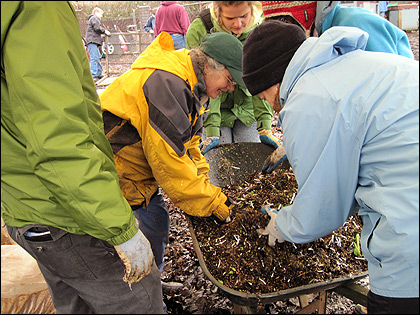
Compost Happens
A little science improves results in backyard composting
By Rachel Foster
Although it was a wintery March day when we met to chat about compost, Sherry Wellborn greeted me in a straw gardening hat. She was making the point that she wears many hats, including two teaching hats: She is a part-time instructor at LCC and also at Chemeketa Community College. The hat she donned as we got down to business was her city hat. As compost educator in the Eugene Planning and Development Department, she leads hands-on composting workshops in Eugene during spring and fall.
 |
| Sherry Wellborn shows how to mix compost |
The first thing Wellborn wants you to know is “compost happens.” Leave organic material in a heap and it will eventually be broken down by natures many agents of decay to form a pleasant, useful material thats midway between recently living organisms (plants, mostly) and a mysterious, highly complex soil component called humus. Composting can also be a precise, science-based endeavor that proceeds much faster and yields a better, cleaner and more predictable product. But Wellborn believes more of us should be making compost at home, even if our methods are haphazard.
Home composting reduces the material going to land fills. When it comes to yard waste, Wellborn asks, “Why are we taking debris offsite to be composted somewhere else and then, many of us, paying to bring it right back to our gardens?” There are basically three ways to make compost successfully at home: cold composting; hot composting, which is more demanding; and composting with red worms. Worm composting is the subject of another article in this paper.
If you add materials to your bin or pile as they become available, cold composting is what usually results. The process is slow but quite effective. It wont kill weed seeds or pathogens, though. A temperature of 131 degrees Fahrenheit is needed to kill dangerous bacteria such as E-coli, and 140 degrees kills seeds. Commercial composters are required to achieve 131 or higher for three days in their giant piles, and most use 150 as a goal. Such hot composting requires a volume of a cubic yard or more of waste, assembled all at one time, with a good mix of materials that provide an appropriate ratio of carbon to nitrogen. Its often best for casual home composters to put diseased or weedy plant material in the yardwaste bin.
The optimal conditions for making compost, hot or cold, are:
Mix materials for a carbon to nitrogen ratio near 25:1 (see below).
Particle size of 1 to 2 inches. Larger pieces are slower to break down. Avoid uniformity to keep plentiful air space for the microbes and other creatures that actually do the work. A shredder is nice, but Wellborn demonstrates what you can do with a machete!
Adequate air and moisture. Some moisture should trickle out if you squeeze a handful of mix. Water is essential, but too much will fill up those vital air spaces and make a smelly, oxygen-deprived mess.
Turn the pile to fluff it up and maintain aeration. (Alternatively, install in your pile a perforated pipe in the shape of an upside down T with the two lower ends capped. Air penetrates from above.)
Wellborns boss at the city, Annie Donahue, recommends that beginners start with stuff that is safe. Dont attempt to compost meat or cheese, for example. On the other hand, dont be afraid of compost ã just wash your hands. Carbon-rich materials include dead leaves, dried plants, shredded paper and sawdust. Good sources of nitrogen are kitchen scraps and peelings, coffee grounds, spent grain, green plants and grass clippings. For tidy cold composting at home, Wellborn recommends the familiar black Earth Machine (popularly known as the Darth Vadar, and available from BRING) as the best value. Its more or less rat-proof if you stand it on a piece of hardware cloth.
Wellborns latest catch-phrase is “Every leaf left behind.” If you want to compost on a scale that will use up a quantity of leaves, it helps to use manure ã preferably from chickens and herbivores only, such as rabbit, llama, horse and dairy manure. Call around for sources ã Wellborn points out that manure is a problem for many operations, and they are often happy to give it away. Aged manure is great. Fresh manure is OK, but get it in the bin fast, cover it with a layer of leaves or sawdust, then wash your hands! Store excess manure in covered plastic bins until you have enough carbon rich material to mix with it.
Recipes for mixes to achieve ideal carbon-nitrogen ratios are posted at http://wkly.ws/11s Look for “Gardening Links” and click on “Composting Information.” Better still, attend one of Wellborns excellent workshops. Just go to the city of Eugene website and search “2011 composting.”
Rachel Foster of Eugene is a writer and garden consultant. She can be reached at rfoster@efn.org